steering ASTON MARTIN V8 VANTAGE 2010 User Guide
[x] Cancel search | Manufacturer: ASTON MARTIN, Model Year: 2010, Model line: V8 VANTAGE, Model: ASTON MARTIN V8 VANTAGE 2010Pages: 947, PDF Size: 43.21 MB
Page 122 of 947

Handles and Lock Mechanisms (01.14)
Body System (01.00)1-10-2 Workshop Manual May 2007
Specifications
Maintenance
Ignition Cylinder Lock - Renew
Removal
1. Remove steering column shroud (see Workshop Manual procedure 11.04.DB Shroud Assembly - Upper and
Lower - Steering Column - Renew).
2. Insert ignition key into steering lock and turn to position 2 (see Figure 1).
3. Push release button down (through hole). 4. Retract barrel by pulling outwards (gently rotate from
side to side) with key (see Figure 2).
5. Remove key from barrel.
Installation
1. Install key to barrel.
2. Install barrel into steering lock housing until button locates properly.
3. Install steering column shroud (see Workshop Manual procedure 11.04.DB Shroud Assembly - Upper and
Lower - Steering Column - Renew).
RH/LH Front Door Latch Assembly -
Renew
Removal
1. Remove glass regulator (see Workshop Manual procedure 01.11.DA/01.11.1DB Regulator - Door Glass
- LH/RH - Renew).
2. Remove aperture seal from inside door.
3. Remove rear rubber cheater panel, fir tree trim pins (x3), and inner glass seal.
4. Disconnect latch mechanism multiplug.
5. Disconnect exterior door handle inner and outer cable.
6. Remove nuts (x3) securing exterior door handle, remove
handle.
7. Loosen upper nut and remo ve lower nut securing key
lock mechanism.
Torque Figures
DescriptionNm
Door handle 5
Latch 9
Repair Operation Time
ItemCode
Ignition Cylinder Lock-Renew 01.14.AD
Figure 1
A0114311
Figure 2
Repair Operation Time (ROT)
ItemCode
Front Door Latch Assembly RH01.14.CE
Front Door Latch Assembly LH01.14.CF
A0114312
Page 133 of 947
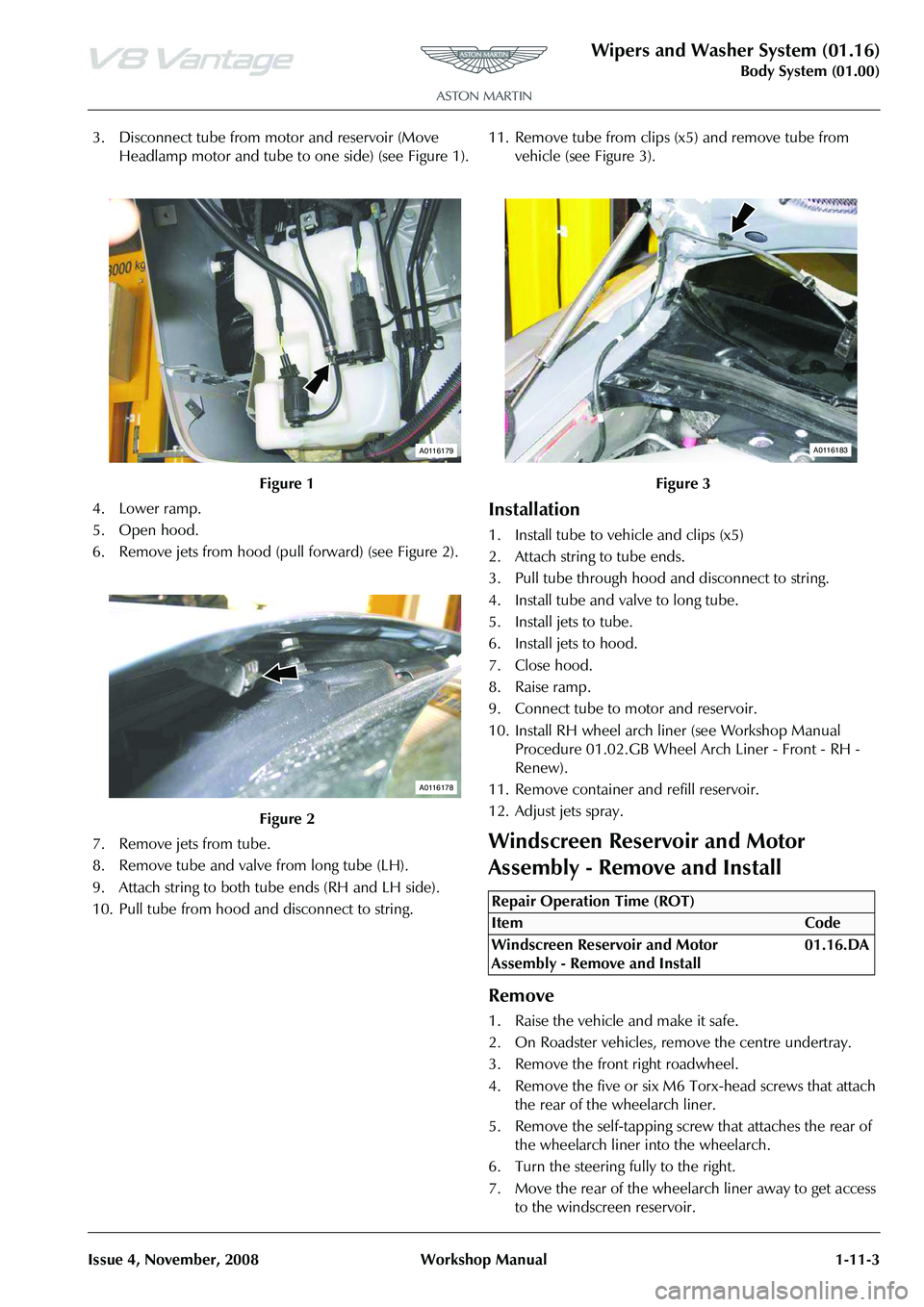
Wipers and Washer System (01.16)
Body System (01.00)
Issue 4, November, 2008 Workshop Manual 1-11-3
3. Disconnect tube from motor and reservoir (Move Headlamp motor and tube to one side) (see Figure 1).
4. Lower ramp.
5. Open hood.
6. Remove jets from hood (pull forward) (see Figure 2).
7. Remove jets from tube.
8. Remove tube and valve from long tube (LH).
9. Attach string to both tube ends (RH and LH side).
10. Pull tube from hood and disconnect to string. 11. Remove tube from clips (x5) and remove tube from
vehicle (see Figure 3).
Installation
1. Install tube to vehicle and clips (x5)
2. Attach string to tube ends.
3. Pull tube through hood and disconnect to string.
4. Install tube and valve to long tube.
5. Install jets to tube.
6. Install jets to hood.
7. Close hood.
8. Raise ramp.
9. Connect tube to motor and reservoir.
10. Install RH wheel arch liner (see Workshop Manual Procedure 01.02.GB Wheel Arch Liner - Front - RH -
Renew).
11. Remove container and refill reservoir.
12. Adjust jets spray.
Windscreen Reservoir and Motor
Assembly - Remove and Install
Remove
1. Raise the vehicle and make it safe.
2. On Roadster vehicles, re move the centre undertray.
3. Remove the front right roadwheel.
4. Remove the five or six M6 Torx-head screws that attach the rear of the wheelarch liner.
5. Remove the self-tapping screw that attaches the rear of the wheelarch liner into the wheelarch.
6. Turn the steering fully to the right.
7. Move the rear of the wheelarch liner away to get access to the windscreen reservoir.
Figure 1
Figure 2
A0116179
A0116178
Figure 3
Repair Operation Time (ROT)
A0116183
Page 134 of 947
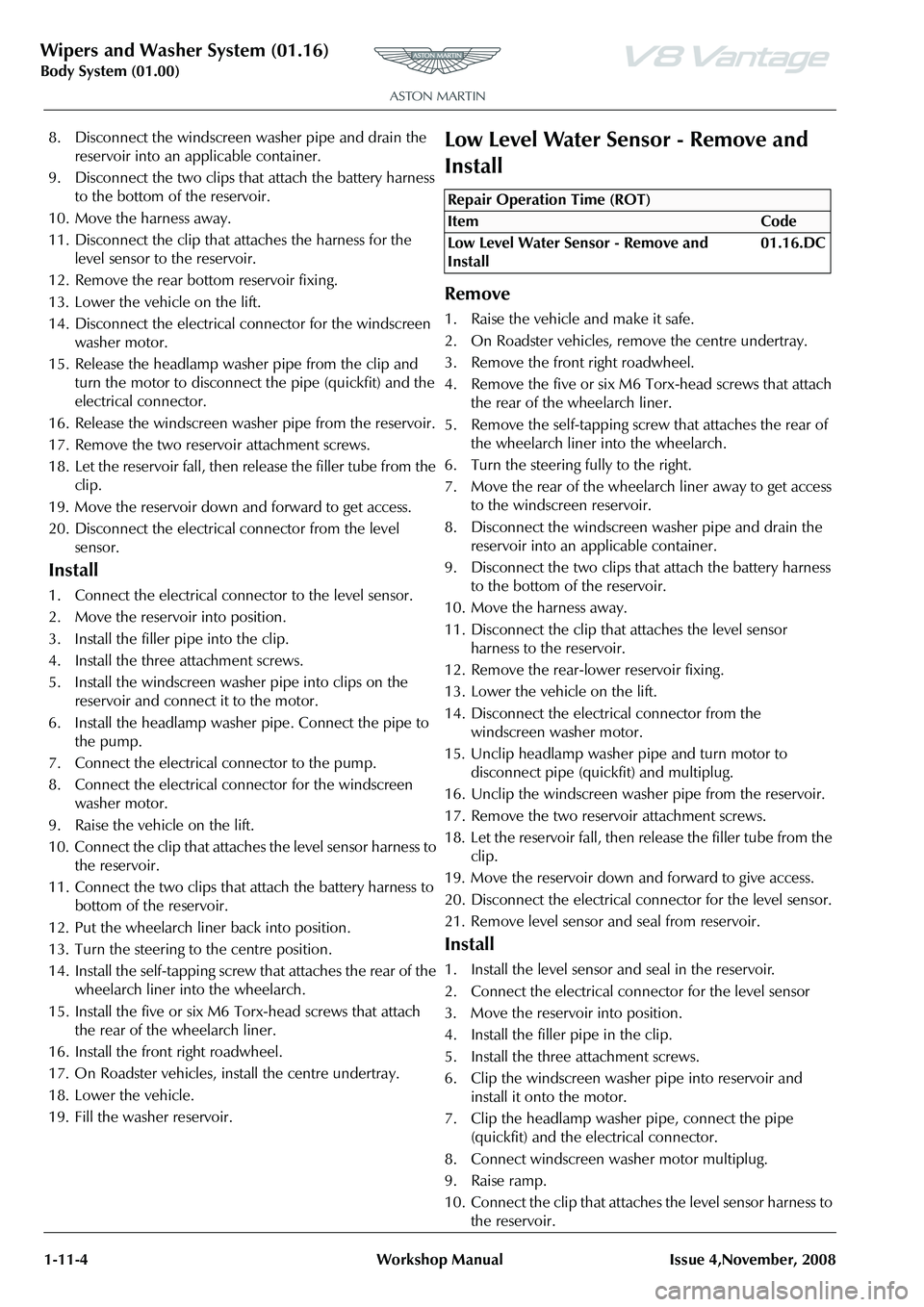
Wipers and Washer System (01.16)
Body System (01.00)1-11-4 Workshop Manual Issue 4,November, 2008
8. Disconnect the windscreen washer pipe and drain the reservoir into an applicable container.
9. Disconnect the two clips that attach the battery harness to the bottom of the reservoir.
10. Move the harness away.
11. Disconnect the clip that attaches the harness for the level sensor to the reservoir.
12. Remove the rear bottom reservoir fixing.
13. Lower the vehicle on the lift.
14. Disconnect the electrical connector for the windscreen washer motor.
15. Release the headlamp washer pipe from the clip and turn the motor to disconnect the pipe (quickfit) and the
electrical connector.
16. Release the windscreen washer pipe from the reservoir.
17. Remove the two reservoir attachment screws.
18. Let the reservoir fall, then release the filler tube from the clip.
19. Move the reservoir down and forward to get access.
20. Disconnect the electrical connector from the level sensor.
Install
1. Connect the electrical connector to the level sensor.
2. Move the reservoir into position.
3. Install the filler pipe into the clip.
4. Install the three attachment screws.
5. Install the windscreen washer pipe into clips on the reservoir and connect it to the motor.
6. Install the headlamp washer pipe. Connect the pipe to the pump.
7. Connect the electrical connector to the pump.
8. Connect the electrical co nnector for the windscreen
washer motor.
9. Raise the vehicle on the lift.
10. Connect the clip that attach es the level sensor harness to
the reservoir.
11. Connect the two clips that attach the battery harness to bottom of the reservoir.
12. Put the wheelarch liner back into position.
13. Turn the steering to the centre position.
14. Install the self-tapping screw that attaches the rear of the wheelarch liner into the wheelarch.
15. Install the five or six M6 Torx-head screws that attach the rear of the wheelarch liner.
16. Install the front right roadwheel.
17. On Roadster vehicles, in stall the centre undertray.
18. Lower the vehicle.
19. Fill the washer reservoir.
Low Level Water Sensor - Remove and
Install
Remove
1. Raise the vehicle and make it safe.
2. On Roadster vehicles, remove the centre undertray.
3. Remove the front right roadwheel.
4. Remove the five or six M6 Torx-head screws that attach the rear of the wheelarch liner.
5. Remove the self-tapping screw that attaches the rear of the wheelarch liner into the wheelarch.
6. Turn the steering fully to the right.
7. Move the rear of the wheelarch liner away to get access to the windscreen reservoir.
8. Disconnect the windscreen washer pipe and drain the reservoir into an applicable container.
9. Disconnect the two clips that attach the battery harness to the bottom of the reservoir.
10. Move the harness away.
11. Disconnect the clip that attaches the level sensor harness to the reservoir.
12. Remove the rear-lower reservoir fixing.
13. Lower the vehicle on the lift.
14. Disconnect the electrical connector from the windscreen washer motor.
15. Unclip headlamp washer pipe and turn motor to disconnect pipe (quickfit) and multiplug.
16. Unclip the windscreen washer pipe from the reservoir.
17. Remove the two reservoir attachment screws.
18. Let the reservoir fall, then release the filler tube from the
clip.
19. Move the reservoir down and forward to give access.
20. Disconnect the electrical connector for the level sensor.
21. Remove level sensor and seal from reservoir.
Install
1. Install the level sensor and seal in the reservoir.
2. Connect the electrical connector for the level sensor
3. Move the reservoir into position.
4. Install the filler pipe in the clip.
5. Install the three attachment screws.
6. Clip the windscreen washer pipe into reservoir and install it onto the motor.
7. Clip the headlamp washer pipe, connect the pipe
(quickfit) and the electrical connector.
8. Connect windscreen washer motor multiplug.
9. Raise ramp.
10. Connect the clip that attaches the level sensor harness to the reservoir.
Repair Operation Time (ROT)
ItemCode
Low Level Water Sensor - Remove and
Install 01.16.DC
Page 135 of 947
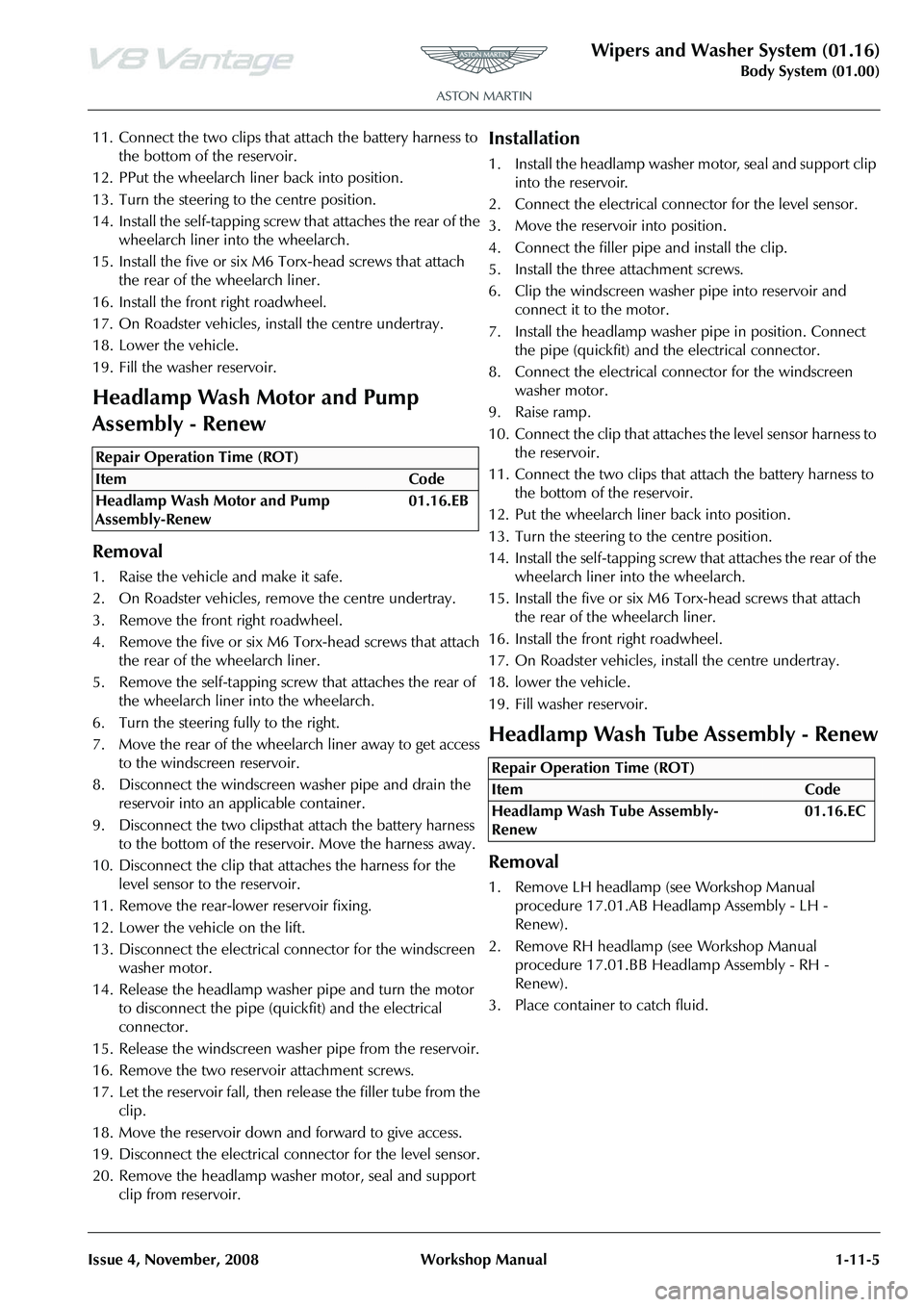
Wipers and Washer System (01.16)
Body System (01.00)
Issue 4, November, 2008 Workshop Manual 1-11-5
11. Connect the two clips that attach the battery harness to the bottom of the reservoir.
12. PPut the wheelarch liner back into position.
13. Turn the steering to the centre position.
14. Install the self-tapping screw that attaches the rear of the wheelarch liner into the wheelarch.
15. Install the five or six M6 Torx-head screws that attach
the rear of the wheelarch liner.
16. Install the front right roadwheel.
17. On Roadster vehicles, in stall the centre undertray.
18. Lower the vehicle.
19. Fill the washer reservoir.
Headlamp Wash Motor and Pump
Assembly - Renew
Removal
1. Raise the vehicle and make it safe.
2. On Roadster vehicles, re move the centre undertray.
3. Remove the front right roadwheel.
4. Remove the five or six M6 Torx-head screws that attach the rear of the wheelarch liner.
5. Remove the self-tapping screw that attaches the rear of the wheelarch liner into the wheelarch.
6. Turn the steering fully to the right.
7. Move the rear of the wheela rch liner away to get access
to the windscreen reservoir.
8. Disconnect the windscreen washer pipe and drain the reservoir into an applicable container.
9. Disconnect the two clipsthat attach the battery harness to the bottom of the reservoir. Move the harness away.
10. Disconnect the clip that attaches the harness for the
level sensor to the reservoir.
11. Remove the rear-lower reservoir fixing.
12. Lower the vehicle on the lift.
13. Disconnect the electrical connector for the windscreen
washer motor.
14. Release the headlamp washer pipe and turn the motor to disconnect the pipe (quickfit) and the electrical
connector.
15. Release the windscreen washer pipe from the reservoir.
16. Remove the two reservoir attachment screws.
17. Let the reservoir fall, then release the filler tube from the clip.
18. Move the reservoir down and forward to give access.
19. Disconnect the electrical co nnector for the level sensor.
20. Remove the headlamp washer motor, seal and support clip from reservoir.
Installation
1. Install the headlamp washer motor, seal and support clip into the reservoir.
2. Connect the electrical connector for the level sensor.
3. Move the reservoir into position.
4. Connect the filler pipe and install the clip.
5. Install the three attachment screws.
6. Clip the windscreen washer pipe into reservoir and connect it to the motor.
7. Install the headlamp washer pipe in position. Connect
the pipe (quickfit) and the electrical connector.
8. Connect the electrical connector for the windscreen washer motor.
9. Raise ramp.
10. Connect the clip that attaches the level sensor harness to the reservoir.
11. Connect the two clips that attach the battery harness to the bottom of the reservoir.
12. Put the wheelarch liner back into position.
13. Turn the steering to the centre position.
14. Install the self-tapping screw that attaches the rear of the wheelarch liner into the wheelarch.
15. Install the five or six M6 Torx-head screws that attach the rear of the wheelarch liner.
16. Install the front right roadwheel.
17. On Roadster vehicles, install the centre undertray.
18. lower the vehicle.
19. Fill washer reservoir.
Headlamp Wash Tube Assembly - Renew
Removal
1. Remove LH headlamp (see Workshop Manual procedure 17.01.AB Headlamp Assembly - LH -
Renew).
2. Remove RH headlamp (see Workshop Manual procedure 17.01.BB Headlamp Assembly - RH -
Renew).
3. Place container to catch fluid.
Repair Operation Time (ROT)
Repair Operation Time (ROT)
Page 215 of 947
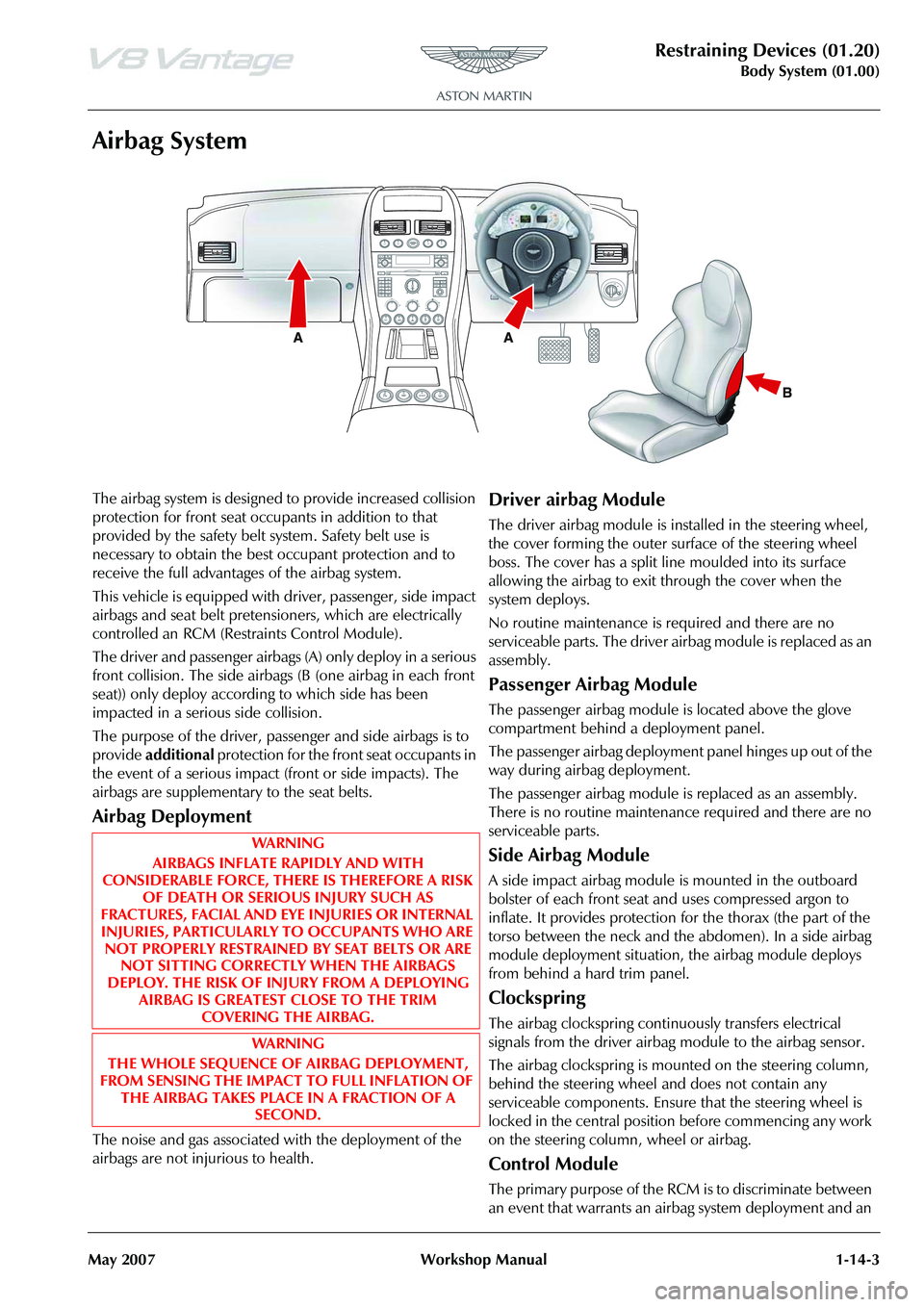
Restraining Devices (01.20)
Body System (01.00)
May 2007 Workshop Manual 1-14-3
Airbag System
The airbag system is designed to provide increased collision
protection for front seat occu pants in addition to that
provided by the safety belt system. Safety belt use is
necessary to obtain the best occupant protection and to
receive the full advantages of the airbag system.
This vehicle is equipped with dr iver, passenger, side impact
airbags and seat belt pretensioners, which are electrically
controlled an RCM (Restraints Control Module).
The driver and passenger airbags (A) only deploy in a serious
front collision. The side airbags (B (one airbag in each front
seat)) only deploy according to which side has been
impacted in a serious side collision.
The purpose of the driver, passenger and side airbags is to
provide additional protection for the front seat occupants in
the event of a serious impact (front or side impacts). The
airbags are supplementary to the seat belts.
Airbag Deployment
The noise and gas associated with the deployment of the
airbags are not injurious to health.
Driver airbag Module
The driver airbag module is installed in the steering wheel,
the cover forming the outer surface of the steering wheel
boss. The cover has a split line moulded into its surface
allowing the airbag to exit through the cover when the
system deploys.
No routine maintenance is required and there are no
serviceable parts. The driver airbag module is replaced as an
assembly.
Passenger Airbag Module
The passenger airbag module is located above the glove
compartment behind a deployment panel.
The passenger airbag deployment panel hinges up out of the
way during airbag deployment.
The passenger airbag module is replaced as an assembly.
There is no routine maintenance required and there are no
serviceable parts.
Side Airbag Module
A side impact airbag module is mounted in the outboard
bolster of each front seat and uses compressed argon to
inflate. It provides protection for the thorax (the part of the
torso between the neck and the abdomen). In a side airbag
module deployment situation, the airbag module deploys
from behind a hard trim panel.
Clockspring
The airbag clockspring continuously transfers electrical
signals from the driver airbag module to the airbag sensor.
The airbag clockspring is mounted on the steering column,
behind the steering wheel and does not contain any
serviceable components. Ensure that the steering wheel is
locked in the central position before commencing any work
on the steering column, wheel or airbag.
Control Module
The primary purpose of the RCM is to discriminate between
an event that warrants an airbag system deployment and an
R P
N
D
WAR NI N G
AIRBAGS INFLATE RAPIDLY AND WITH
CONSIDERABLE FORCE, THERE IS THEREFORE A RISK OF DEATH OR SERIOUS INJURY SUCH AS
FRACTURES, FACIAL AND EY E INJURIES OR INTERNAL
INJURIES, PARTICULARLY TO OCCUPANTS WHO ARE NOT PROPERLY RESTRAINED BY SEAT BELTS OR ARE NOT SITTING CORRECTLY WHEN THE AIRBAGS
DEPLOY. THE RISK OF IN JURY FROM A DEPLOYING
AIRBAG IS GREATEST CLOSE TO THE TRIM COVERING THE AIRBAG.
WAR NI N G
THE WHOLE SEQUENCE OF AIRBAG DEPLOYMENT,
FROM SENSING THE IMPACT TO FULL INFLATION OF THE AIRBAG TAKES PLACE IN A FRACTION OF A SECOND.
Page 216 of 947
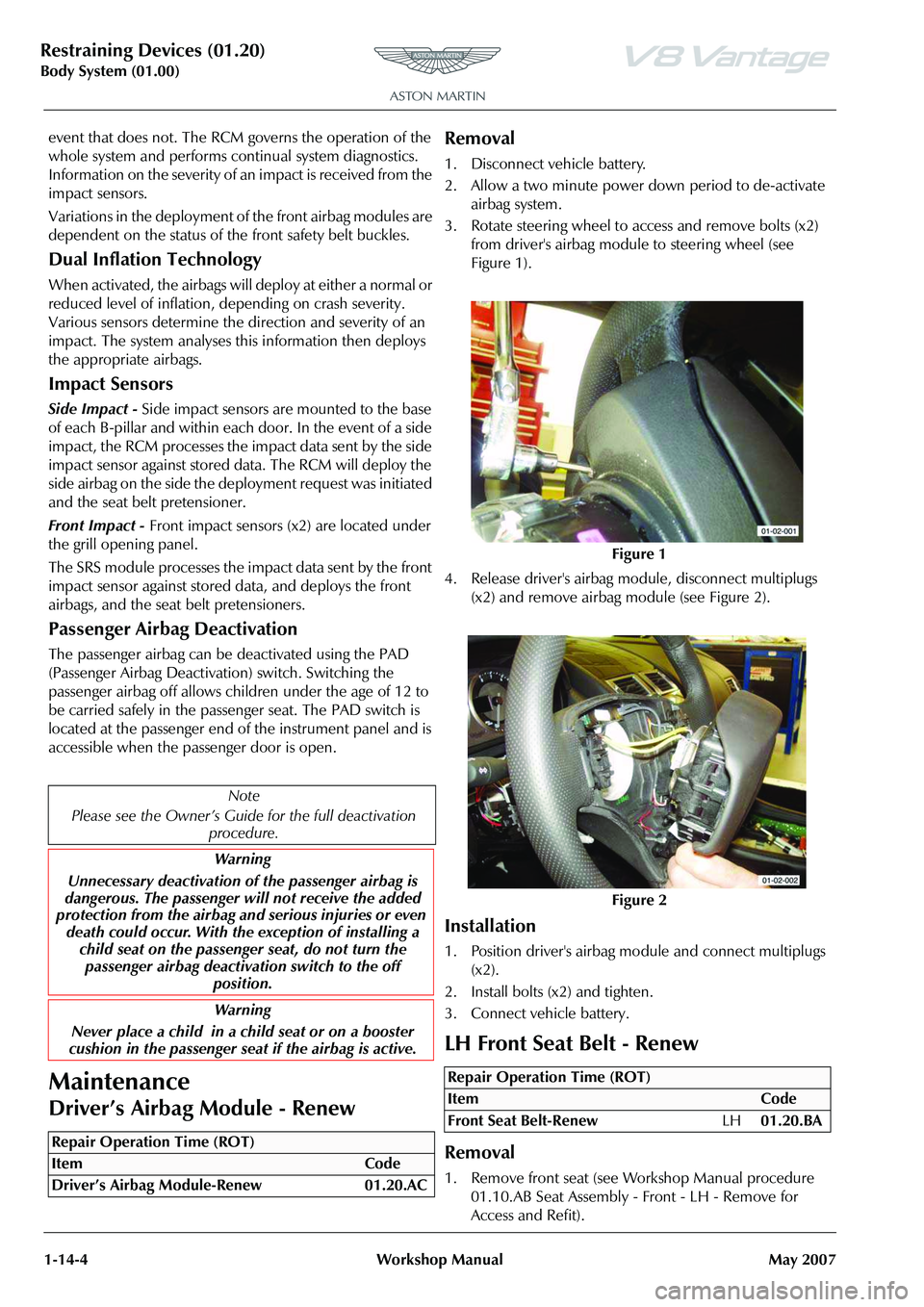
Restraining Devices (01.20)
Body System (01.00)1-14-4 Workshop Manual May 2007
event that does not. The RCM governs the operation of the
whole system and performs continual system diagnostics.
Information on the severity of an impact is received from the
impact sensors.
Variations in the deployment of the front airbag modules are
dependent on the status of the front safety belt buckles.
Dual Inflation Technology
When activated, the airbags will deploy at either a normal or
reduced level of inflation, depending on crash severity.
Various sensors determine the direction and severity of an
impact. The system analyses this information then deploys
the appropriate airbags.
Impact Sensors
Side Impact - Side impact sensors are mounted to the base
of each B-pillar and within each door. In the event of a side
impact, the RCM processes the impact data sent by the side
impact sensor against stored data. The RCM will deploy the
side airbag on the side the deployment request was initiated
and the seat belt pretensioner.
Front Impact - Front impact sensors (x2) are located under
the grill opening panel.
The SRS module processes the impact data sent by the front
impact sensor against stored data, and deploys the front
airbags, and the seat belt pretensioners.
Passenger Airbag Deactivation
The passenger airbag can be deactivated using the PAD
(Passenger Airbag Deactivation) switch. Switching the
passenger airbag off allows children under the age of 12 to
be carried safely in the passenger seat. The PAD switch is
located at the passenger end of the instrument panel and is
accessible when the pa ssenger door is open.
Maintenance
Driver’s Airbag Module - Renew
Removal
1. Disconnect vehicle battery.
2. Allow a two minute power down period to de-activate
airbag system.
3. Rotate steering wheel to access and remove bolts (x2) from driver's airbag module to steering wheel (see
Figure 1).
4. Release driver's airbag mo dule, disconnect multiplugs
(x2) and remove airbag module (see Figure 2).
Installation
1. Position driver's airbag mo dule and connect multiplugs
(x2).
2. Install bolts (x2) and tighten.
3. Connect vehicle battery.
LH Front Seat Belt - Renew
Removal
1. Remove front seat (see Workshop Manual procedure 01.10.AB Seat Assembly - Front - LH - Remove for
Access and Refit).
Note
Please see the Owner’s Guid e for the full deactivation
procedure.
Warning
Unnecessary deactivation of the passenger airbag is
dangerous. The passenger will not receive the added
protection from the airbag and serious injuries or even
death could occur. With the exception of installing a child seat on the passenge r seat, do not turn the
passenger airbag deactiva tion switch to the off
position.
Warning
Never place a child in a child seat or on a booster
cushion in the passenger seat if the airbag is active.
Repair Operation Time (ROT)
Figure 1
Figure 2
Repair Operation Time (ROT)
ItemCode
Front Seat Belt-Renew LH01.20.BA
Page 224 of 947
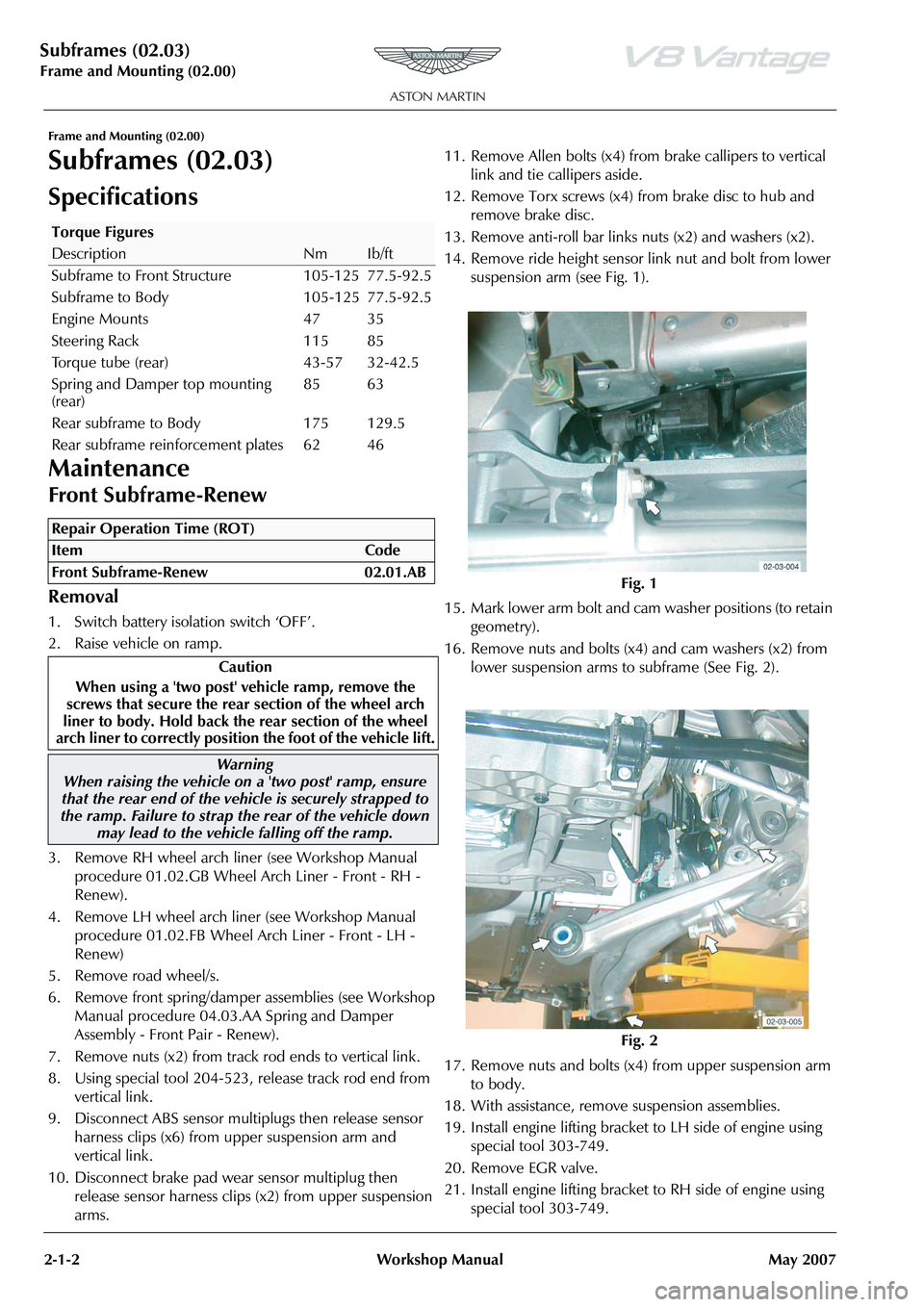
Subframes (02.03)
Frame and Mounting (02.00)
2-1-2 Workshop Manual May 2007
Frame and Mounting (02.00)
Subframes (02.03)
Specifications
Maintenance
Front Subframe-Renew
Removal
1. Switch battery isolation switch ‘OFF’.
2. Raise vehicle on ramp.
3. Remove RH wheel arch liner (see Workshop Manual procedure 01.02.GB Wheel Arch Liner - Front - RH -
Renew).
4. Remove LH wheel arch liner (see Workshop Manual procedure 01.02.FB Wheel Arch Liner - Front - LH -
Renew)
5. Remove road wheel/s.
6. Remove front spring/damper assemblies (see Workshop Manual procedure 04.03.AA Spring and Damper
Assembly - Front Pair - Renew).
7. Remove nuts (x2) from track rod ends to vertical link.
8. Using special tool 204-523, release track rod end from vertical link.
9. Disconnect ABS sensor multiplugs then release sensor harness clips (x6) from upper suspension arm and
vertical link.
10. Disconnect brake pad wear sensor multiplug then release sensor harness clips (x2) from upper suspension
arms. 11. Remove Allen bolts (x4) from brake callipers to vertical
link and tie callipers aside.
12. Remove Torx screws (x4) from brake disc to hub and remove brake disc.
13. Remove anti-roll bar links nuts (x2) and washers (x2).
14. Remove ride height sensor link nut and bolt from lower
suspension arm (see Fig. 1).
15. Mark lower arm bolt and cam washer positions (to retain
geometry).
16. Remove nuts and bolts (x4) and cam washers (x2) from lower suspension arms to subframe (See Fig. 2).
17. Remove nuts and bolts (x4) from upper suspension arm to body.
18. With assistance, remove suspension assemblies.
19. Install engine lifting bracket to LH side of engine using special tool 303-749.
20. Remove EGR valve.
21. Install engine lifting bracket to RH side of engine using special tool 303-749.
Torque Figures
DescriptionNmIb/ft
Subframe to Front Structure 105-125 77.5-92.5
Subframe to Body 105-125 77.5-92.5
Engine Mounts 47 35
Steering Rack 115 85
Torque tube (rear) 43-57 32-42.5
Spring and Damper top mounting
(rear) 85 63
Rear subframe to Body 175 129.5
Rear subframe reinforcement plates 62 46
Repair Operation Time (ROT)
Warning
When raising the vehicle on a 'two post' ramp, ensure
that the rear end of the vehi cle is securely strapped to
the ramp. Failure to strap th e rear of the vehicle down
may lead to the vehicl e falling off the ramp.
Fig. 1
Fig. 2
Page 225 of 947

Subframes (02.03)
Frame and Mounting (02.00)
May 2007 Workshop Manual 2-1-3
22. Install cross brace support brackets 303-021-02 (x6).
23. Support engine using special tool SPX M553D.
24. Remove undertray (see Workshop Manual procedure 01.02.NB Undertray - Front - Renew).
25. Remove engine mounting nuts (x2) (see Fig. 3).
26. Remove steering rack nuts (x3) from bolts and retain bolts in steering rack (see Fig. 4).
27. Mark subframe position (see Fig. 5). 28. Remove harness clips (x2).
29. Remove nut and bolt securi
ng ride height sensor to
subframe.
30. Prepare support trolley 30 3-F715 with adaptors 303-
F715 051 to 4.
31. Position trolley, support subframe, remove bolts (x12)
and raise vehicle (see Fig. 6).
32. Remove anti-roll bar from subframe (bolts x4).
33. With assistance, remove subframe from trolley.
Installation
1. With assistance, install subframe on trolley.
2. Install anti-roll bar to subframe (Do not torque bolts at this stage).
3. Install subframe to body (remove trolley).
4. Install harness clips (x2).
5. Install steering rack nuts (x3) and tighten.
6. Install engine mounting nuts (x2) and tighten.
7. Install ride height sensor.
8. Install undertray (see Workshop Manual procedure 01.02.NB Undertray - Front - Renew).
9. Lower ramp.
10. Remove engine lifting beam.
11. Remove special tool SPX M553D.
12. Remove engine lifting brack ets from engine (303-749).
13. Remove cross brace suppo rt bracket fixings (x6).
14. Install EGR valve and tighten.
15. Install front spring and damper assemblies (see Workshop Manual procedure 04.03.AA Spring and
Damper Assembly - Front Pair - Renew).
16. Install RH wheel arch li ner (see Workshop Manual
procedure 01.02.GB Wheel Arch Liner - Front - RH -
Renew).
17. Install LH wheel arch liner (see Workshop Manual procedure 01.02.FB Wheel Arch Liner - Front - LH -
Renew)
Fig. 3
Fig. 4
Fig. 5
Fig. 6
Ensure that the sub-frame mo untings to body structure
marks are correctly aligned.
Page 227 of 947
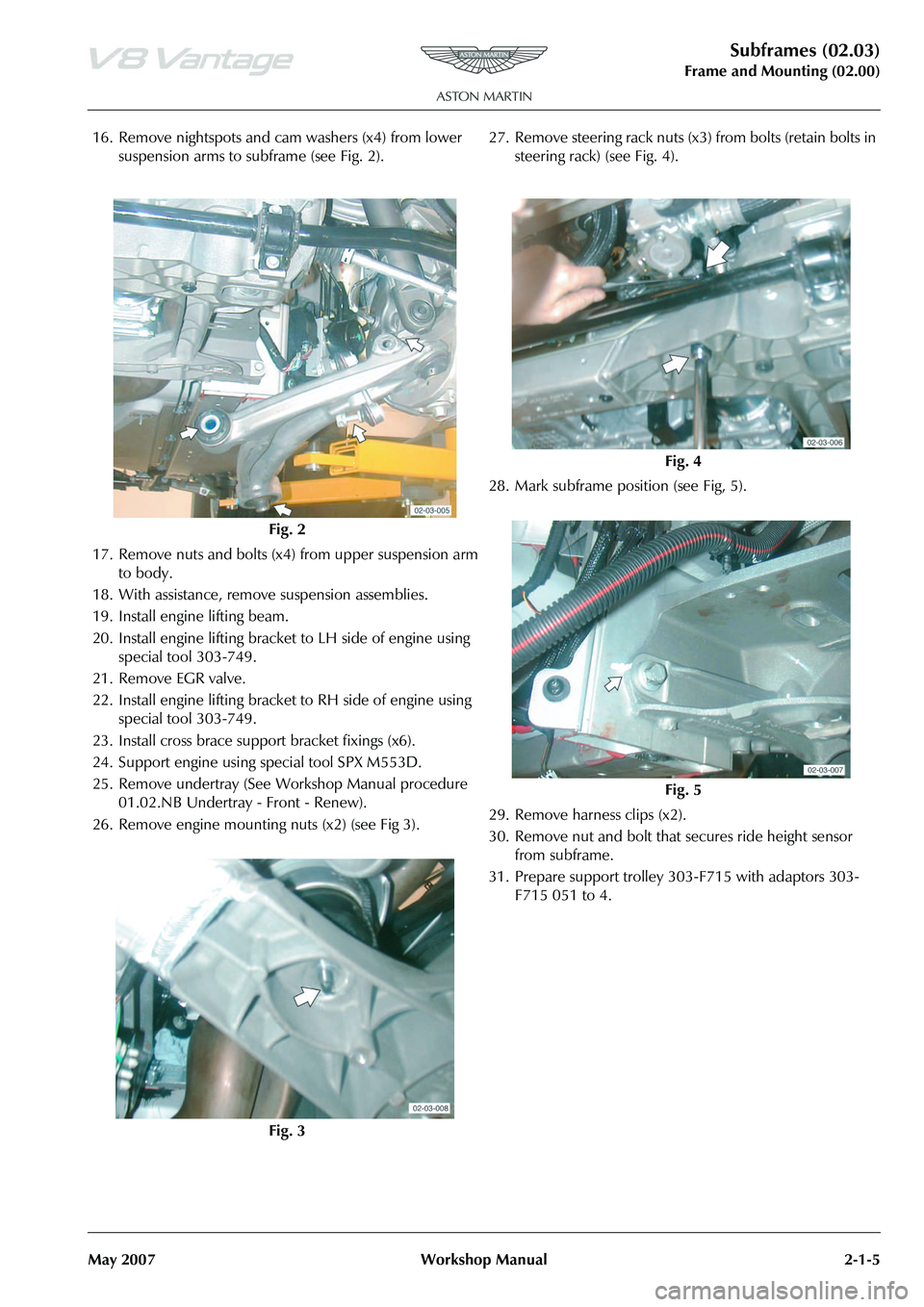
Subframes (02.03)
Frame and Mounting (02.00)
May 2007 Workshop Manual 2-1-5
16. Remove nightspots and cam washers (x4) from lower suspension arms to subframe (see Fig. 2).
17. Remove nuts and bolts (x4) from upper suspension arm to body.
18. With assistance, remove suspension assemblies.
19. Install engine lifting beam.
20. Install engine lifting bracket to LH side of engine using
special tool 303-749.
21. Remove EGR valve.
22. Install engine lifting bracket to RH side of engine using special tool 303-749.
23. Install cross brace support bracket fixings (x6).
24. Support engine using special tool SPX M553D.
25. Remove undertray (See Workshop Manual procedure 01.02.NB Undertray - Front - Renew).
26. Remove engine mounting nuts (x2) (see Fig 3). 27. Remove steering rack nuts (x3) from bolts (retain bolts in
steering rack) (see Fig. 4).
28. Mark subframe position (see Fig, 5).
29. Remove harness clips (x2).
30. Remove nut and bolt that secures ride height sensor
from subframe.
31. Prepare support trolley 30 3-F715 with adaptors 303-
F715 051 to 4.
Fig. 2
Fig. 3
Fig. 4
Fig. 5
Page 228 of 947
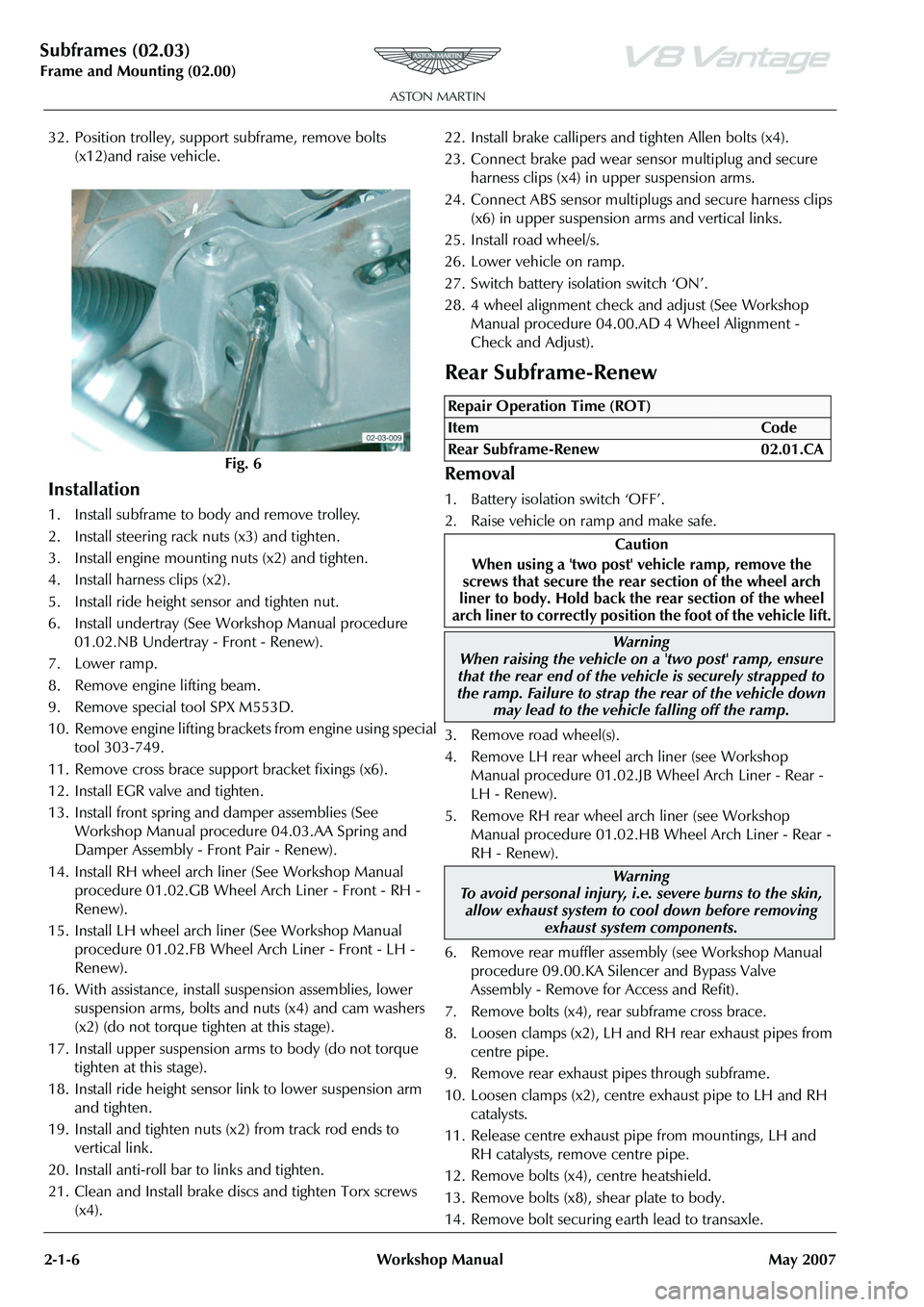
Subframes (02.03)
Frame and Mounting (02.00)
2-1-6 Workshop Manual May 2007
32. Position trolley, support subframe, remove bolts (x12)and raise vehicle.
Installation
1. Install subframe to body and remove trolley.
2. Install steering rack nuts (x3) and tighten.
3. Install engine mounting nuts (x2) and tighten.
4. Install harness clips (x2).
5. Install ride height sensor and tighten nut.
6. Install undertray (See Workshop Manual procedure 01.02.NB Undertray - Front - Renew).
7. Lower ramp.
8. Remove engine lifting beam.
9. Remove special tool SPX M553D.
10. Remove engine lifting bracket s from engine using special
tool 303-749.
11. Remove cross brace support bracket fixings (x6).
12. Install EGR valve and tighten.
13. Install front spring and damper assemblies (See Workshop Manual procedure 04.03.AA Spring and
Damper Assembly - Front Pair - Renew).
14. Install RH wheel arch liner (See Workshop Manual procedure 01.02.GB Wheel Arch Liner - Front - RH -
Renew).
15. Install LH wheel arch liner (See Workshop Manual procedure 01.02.FB Wheel Arch Liner - Front - LH -
Renew).
16. With assistance, install suspension assemblies, lower suspension arms, bolts and nuts (x4) and cam washers
(x2) (do not torque tighten at this stage).
17. Install upper suspension arms to body (do not torque tighten at this stage).
18. Install ride height sensor link to lower suspension arm and tighten.
19. Install and tighten nuts (x2) from track rod ends to vertical link.
20. Install anti-roll bar to links and tighten.
21. Clean and Install brake discs and tighten Torx screws (x4). 22. Install brake callipers and tighten Allen bolts (x4).
23. Connect brake pad wear se
nsor multiplug and secure
harness clips (x4) in upper suspension arms.
24. Connect ABS sensor multiplu gs and secure harness clips
(x6) in upper suspension arms and vertical links.
25. Install road wheel/s.
26. Lower vehicle on ramp.
27. Switch battery isolation switch ‘ON’.
28. 4 wheel alignment check and adjust (See Workshop Manual procedure 04.00.AD 4 Wheel Alignment -
Check and Adjust).
Rear Subframe-Renew
Removal
1. Battery isolation switch ‘OFF’.
2. Raise vehicle on ramp and make safe.
3. Remove road wheel(s).
4. Remove LH rear wheel arch liner (see Workshop Manual procedure 01.02.JB Wheel Arch Liner - Rear -
LH - Renew).
5. Remove RH rear wheel arch liner (see Workshop Manual procedure 01.02.HB Wheel Arch Liner - Rear -
RH - Renew).
6. Remove rear muffler asse mbly (see Workshop Manual
procedure 09.00.KA Silencer and Bypass Valve
Assembly - Remove for Access and Refit).
7. Remove bolts (x4), rear subframe cross brace.
8. Loosen clamps (x2), LH and RH rear exhaust pipes from
centre pipe.
9. Remove rear exhaust pipes through subframe.
10. Loosen clamps (x2), centre exhaust pipe to LH and RH
catalysts.
11. Release centre exhaust pipe from mountings, LH and RH catalysts, remove centre pipe.
12. Remove bolts (x4), centre heatshield.
13. Remove bolts (x8), shear plate to body.
14. Remove bolt securing earth lead to transaxle.
Fig. 6
Repair Operation Time (ROT)
ItemCode
Rear Subframe-Renew 02.01.CA
Caution
When using a 'two post' vehicle ramp, remove the
screws that secure the rear section of the wheel arch
liner to body. Hold back the rear section of the wheel
arch liner to correctly position the foot of the vehicle lift.
Warning
When raising the vehicle on a 'two post' ramp, ensure
that the rear end of the vehi cle is securely strapped to
the ramp. Failure to strap th e rear of the vehicle down
may lead to the vehicl e falling off the ramp.
Warning
To avoid personal injury, i.e. severe burns to the skin, allow exhaust system to cool down before removing
exhaust system components.